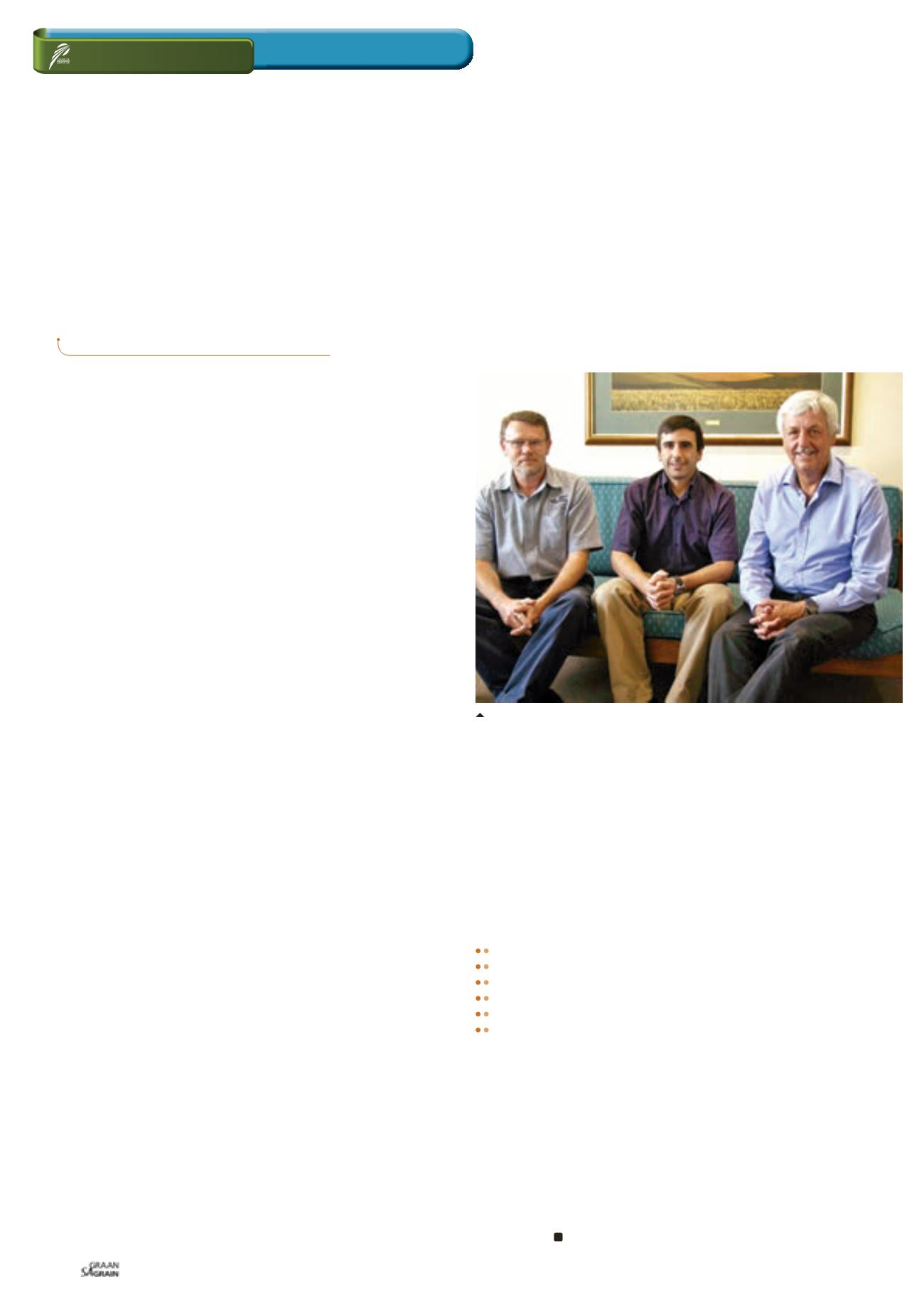

Wheat quality expert visits ARC-SGI’s
Cereal Chemistry Laboratory
D
r Carlos Guzman Garcia, head of the Wheat Chemistry
and Quality Laboratory at the International Centre for
Wheat and Maize Improvement (CIMMYT) in El Batan,
Mexico, visited South Africa in January this year. He was
invited by the ARC-Small Grain Institute (ARC-SGI) in Bethlehem.
The CIMMYT maintains one of the world’s largest and most
diverse wheat and maize seed collections, with approximately 180
specialised researchers from 40 countries, along with 700 support
staff, working at five research stations in Mexico and 18 offices in
the developing world.
Recent estimates indicate that wheat varieties developed by the
CIMMYT and its partners are planted on more than 64 million
hectares in developing countries, representing more than 75% of
modern wheat varieties planted in those countries. Most South
African grown wheat varieties derive from CIMMYT-germplasm.
Dr Guzman Garcia presented talks at the ARC-SGI and the
universities of the Free State and Stellenbosch on: Wheat quality
improvement at CIMMYT; Quality selections for segregating and
advanced wheat material; Rheology, electrophoresis and marker
assisted selection.
The CIMMYT has the largest wheat breeding programme in the
world and accommodates two cycles per year by means of a shut-
tle programme. Their main focus is to select for high adaptability,
high yield, disease resistance as well as heat and drought tolerance.
Wheat quality forms an integral part of their breeding programme.
During 2014 they evaluated 5 000 bread wheat lines and 10 000
durum wheat lines. High throughput methodologies are applied to
screen samples. Some methods are modified to minimise sample
size and the time required for analysis. Adjusted methods are
validated against internationally approved methods.
Quality is a complex trait and can be subdivided into milling
quality (high flour yield), processing quality (production of uniform
products with minimum cost), end-use quality (according to
consumer preference) and nutritional value. Wheat quality is a
variable concept, depending on the type of end-product, process-
ing conditions (automated, semi-automated or manual) and con-
sumer preference.
Main factors influencing wheat quality are grain morphology (mill-
ing quality), kernel hardness (flour yield and end-use quality), protein
content and composition (processing, end-use and nutritional
quality) and flour colour (end-use quality). Kernel hardness is
regarded as the most important trait since it affects processing and
end-use quality and is therefore classified accordingly.
Hard kernels require more time and energy during the milling
process while soft kernels require more sifting time and renders
lower flour yield. Hard kernels are prone to starch damage resulting
in higher water absorption, a desirable trait for bread making,
while soft kernels are more suitable for cookies due to lower water
absorption levels.
It is more efficient to improve end-use quality by means of improv-
ing protein quality than protein content. The CIMMYT selects for
protein composition and not protein content since protein content
is strongly influenced by the environment and is negatively associa-
ted with grain yield.
Wheat breeding lines are classified in six classes according to flour
analysis, with the first two classes being of the highest quality:
Pan-type bread for the mechanised industry
Leavened bread for the semi-mechanised industry
Dense and flat bread for manual baking
Cookies
Poor, inferior quality
Discard
Plant breeders and scientific institutions across the world have
open access to germplasm and methodologies developed by the
CIMMYT, since it is a non-profit organisation. Plant breeders and
students receive training and further their studies on a regular basis
at the CIMMYT.
Collaboration between the Cereal Chemistry Laboratory (ARC-SGI)
and the CIMMYT (Wheat Chemistry and Quality Laboratory) was
established during the visit of Dr Guzman Garcia.
We are grateful to the Winter Cereal Trust for funding Dr Guzman
Garcia’s visit.
BAREND WENTZEL,
ARC-Small Grain Institute
Barend Wentzel (ARC-SGI), Dr Carlos Guzman Garcia (CIMMYT, Mexico)
and Dr Cobus le Roux (general manager, ARC-Field Crops division).
Mei 2015
80
RELEVANT

















